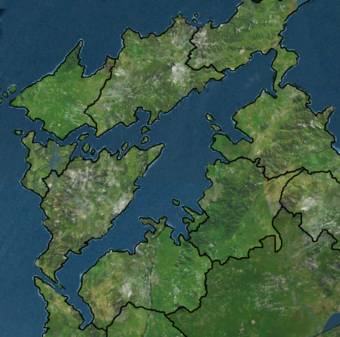Croix Sea: Difference between revisions
(Created page with "{{Infobox body of water | name = Croix Sea | image = Croix Sea map.jpg | alt = A map of the Croix Sea | caption = | image_bathymetry = | caption_bathymetry = | location = Ad...") |
No edit summary |
||
| Line 1: | Line 1: | ||
{{Infobox body of water | {{Infobox body of water | ||
| name = Croix Sea | | name = Croix Sea | ||
| image = Croix Sea map. | | image = Croix Sea map.png | ||
| alt = A map of the Croix Sea | | alt = A map of the Croix Sea | ||
| caption = | | caption = | ||
Latest revision as of 22:17, 24 April 2021
| Croix Sea | |
|---|---|
 | |
| Location | Southern Adula |
| Type | Sea |
| Primary outflows | Emmiria Sea, Gulf of Semalia |
| Catchment area | 235,000 km2 (91,000 sq mi) |
| Basin countries | Bordering: Alecburgh, Saint Croix and Bens, Qolaysia, Nebetia, Cyruda, Bazira, and Al-Zaadi |
| Max. length | 800 km (500 mi) |
| Max. width | 200 km (120 mi) |
| Surface area | 138,600 km2 (53,500 sq mi) |
| Average depth | 252.5 m (828 ft) |
| Max. depth | 1,233 m (4,045 ft) |
| Water volume | 35,000 km3 (2.8×1010 acre⋅ft) |
| Residence time | 3.4±0.4 years |
| wikipedia:Salinity | 38–39 PSU |
| Max. temperature | 28 °C (82 °F) |
| Min. temperature | 9 °C (48 °F) |
| Islands | Over 1300 |
| Settlements | Beresa, Sakoyva, Neregas, Santos, Dawea |
The Croix Sea is a body of water separating the Bazira Peninsula from the Qolaysian Peninsula in Southern Adula. The Croix is the southernmost arm of the Emmiria Sea, extending from the Gulf of Semalia and the Gelci Strait. The countries with coasts on the Croix are Alecburgh, Saint Croix and Bens, Qolaysia, Nebetia, Cyruda, Bazira, and Al-Zaadi.
The Croix contains over 1,300 islands, mostly located along the Saint Croix and Bens and Nebetian part of its northwestern coast through the Gelci Strait. It is divided into three basins, the northern being the shallowest and the southern being the deepest, with a maximum depth of 1,233 metres (4,045 ft). Tidal movements in the Croix are slight, although larger amplitudes are known to occur occasionally. The Croix's salinity is lower than the Emmiria Sea's because the Adriatic collects a third of the fresh water flowing into the Emmiria and Gulf of Semalia, acting as a dilution basin. The surface water temperatures generally range from 30 °C (86 °F) in summer to 12 °C (54 °F) in winter, significantly moderating the Croix Basin's climate.
Fisheries and tourism are significant sources of income all along the Croix coast. Qolaysia and Saint Croix and Bens' Croix Sea tourism industry has grown faster economically than the rest of the Croix Basin's. Maritime transport is also a significant branch of the area's economy—there are 19 seaports in the Croix that each handle more than a million tonnes of cargo per year. The largest Croix seaport by annual cargo turnover is the Port of Beresa, while the Port of Neregas is the largest Croix seaport by passengers served per year.
Geography
Biogeography and ecology
Flora and fauna
The unique nature of the Croix gives rise to an abundance of endemic flora and fauna. The Qolaysia Marine Exploration Organization identified more than 7,000 animal and plant species in the Croix Sea. The Central Croix is especially abundant in endemic plant species, with 535 identified species of green, brown and red algae. Four out of five Emmiria seagrass species are found in the Croix Sea. The most common species are Cymodocea nodosa and Zostera noltii, while Zostera marina and Posidonia oceanica are comparatively rare.
A number of rare and threatened species are also found along the Croix's eastern coast; it is relatively clearer and less polluted than the western Croix coast—in part because the sea currents flow through the Croix in a counterclockwise direction, thus bringing clearer waters up the eastern coast and returning increasingly polluted water down the western coast. This circulation has significantly contributed to the biodiversity of the countries along the eastern Croix coast; the common bottlenose dolphin is frequent in the eastern coast's waters only, and the Cyruda coast provides refuge for the critically endangered monk seal and sea turtles. Recent studies revealed that cetaceans and other marine megafaunas, that were once thought to be vagrants to Croix Sea, migrate and live in the semi-closed sea on larger scales. Largest of these live normally is the fin whale, and sperm whale, the largest of toothed whales also migrate but less common than fin whales, followed by beaked whales. Basking sharks and manta rays are some of migrant species to the sea.
Tuna has been caught by the locals in the upper Croix for thousands of years. The very large schools consisted mainly of little tunny. However, increasing fishing prevented the migration of large schools of fish to the north.